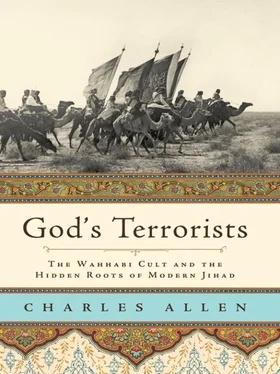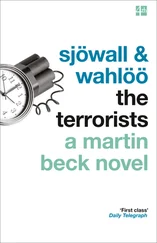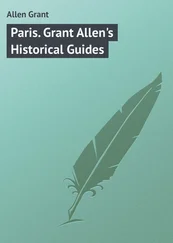armed with a panoply of spectacles and owl-like looks, miraculous rosaries, infallible amulets, and tables of descent from the Prophet Muhommud. Each newcomer, like St Peter, held the keys of heaven; and the whole, like Irish beggars, were equally prepared to bless or curse to all eternity him who gave or him who withheld… To be cursed in Arabic, or anything that sounded like it; to be told that the blessed Prophet had put a black mark against his soul, for not giving his best field to one of the Prophet’s own posterity; to have the saliva of a disappointed saint left in anger on his doorpost; or behold a Hajee, who had gone three times to Mecca, deliberately sit down and enchant his camels with the itch, and his sheep with the rot: these were things which made the dagger drop out of the hand of the awe-stricken savage, his knees knock together, his liver turn to water, and his parched tongue to be scarce able to articulate a full and complete concession of the blasphemous demand.
The Corps of Guides surgeon Dr Henry Bellew also noted this same propensity for religious subservience among the Yusufzai. ‘They are’, he declared, ‘entirely controlled by their priests, and are at all times ready for a jahad [jihad], be the infidels black or white… An inordinate reverence for saints and the religious classes generally is universal, and their absurdly impossible and contradictory dicta are received and acted upon with eager credulity.’ Half a century later Winston Churchill, then a junior officer with the 4th Hussars, came to exactly the same conclusion. ‘Their superstition’, he wrote of the Pathans, ‘exposes them to the rapacity and tyranny of a numerous priesthood – Mullahs, Sahibzadas, Akhundzadas, Fakirs – and a host of wandering Talib-ul-ulms , who correspond with the theological students in Turkey, and live free at the expense of the people.’
When Dr Bellew came to set down his General Report on the Yusufzais in 1864, he singled out two groups of clergy as having particular influence over the Pathans. The first were the Saiyyeds, of Arab extraction and believed to be the direct descendants of Caliph Ali, the son-in-law of the Prophet: ‘Their origin being from so holy a source, they are, of course, esteemed as uncommonly holy persons. Their bold, obtrusive, and continual publication of their sacred character and descent draws from the ignorant a reverential and awful respect, and at the same time gives them great influence over the mass of the population they dwell among. They use this to their own advantage and manage to get from the Afghans [i.e., Pathans] considerable tracts of land in gift as a perpetual and hereditary possession.’
Bellew’s second group provided the most active portion of the clergy. Every mosque had its imam , who led the congregation in prayers, supported in the larger mosques by a number of religious teachers, known variously as mullahs , maulvis or maulanas : ‘They call the azan [summons to prayer], and perform the prayers and other duties of the Imam in his absence. They are mostly occupied in teaching the Talib-ul-ulm the Kuran [Quran], the forms of prayer, and the doctrines of Islam, and the village children how to repeat their “belief” and say their prayers.’ Dr Bellew’s ‘Talib-ul-ulm’ were more correctly taliban-ul-ulm , literally ‘seekers of knowledge’, or religious students. He categorised them as ‘a mixed class of vagrants and idlers, who, under the pretence of devoting themselves to religion, wander from country to country; and, on the whole, lead an agreeable and easy life. Wherever they go they find shelter in the mosques, and can always get a sufficiency of food for the mere asking. As a rule, they are very ignorant and remarkably bigoted.’
Edwardes, Bellew and the British officers who came after them loathed these saiyyeds, imams, mullahs, maulvis, maulanas and taliban in equal measure. They saw the ulema, because of their influence over their flocks, as a threat to British authority and their influence on the tribespeople as wholly negative. That loathing was returned in equal if not greater measure by the sayyeds, mullahs, maulvis, maulanas and taliban, who considered the British not merely a threat to their authority but also a threat to their religion. In 1847 a would-be assassin caught and disarmed by Herbert Edwardes’ guards was found to have been acting on the instructions of a mullah. In 1853 John Nicholson shot a man advancing on him with a sword, an assailant whom he later described as ‘religiously mad’. This man, too, had been put up to it by what Nicholson described as a ‘religious instructor’. As the gravestones in the Christian cemeteries of Peshawar, Kohat, Bannu and elsewhere on the Frontier testify, scores of acts of violence against individual Britons were perpetrated over the next century.
My youngest daughter has a beautiful gold-threaded scarf that once belonged to an English doctor named Flora Butcher. Miss Butcher wanted to be a doctor at a time in Britain when women were not allowed to enter the profession, so she went to Belgium to study. After qualifying, she had hoped to practise in India but was refused permission to do so by the British authorities. Undaunted, she proceeded up the Khyber Pass, to set up a medical mission in tribal territory, where she and a small band of devoted Indians ministered with great success to the local tribes-people. Towards the end of 1927 her friends became concerned by the non-appearance of the pack ponies that kept her supplied, enquiries were made, and it was discovered that Miss Butcher and most of her staff had been murdered. She was only one of a number of doctors targeted and assassinated on the Frontier at that time by what the British termed ‘fanatics’.
In Soldier Sahibs I interpreted these killings by tribesmen as part and parcel of the Pathans’ traditional propensity for violence and their antipathy to outside interference. I was quite wrong. What I had missed was something infinitely more serious: a series of insurgencies and assassinations increasingly directed by a movement whose adherents saw themselves as engaging in a great religious struggle in defence of Islam but who were (as they still are) profoundly at odds with that same religion; a movement dedicated not simply to protecting Islam, as its adherents protested (and still protest), but to the destruction of all interpretations of religion other than its own; a movement that worked time and time again to bring the people of the Frontier out in armed revolt, and which in 1857 played an unacknowledged part in the struggle to overthrow British rule in India; a movement brought to the verge of extinction many times over but whose ideology was always kept alive – and which today is not only back in business but whose appeal and authority is greater than it has ever been.
The founder of this movement saw himself as a reformer and described those who followed his teachings as Al-Muwahhidun , or the Unitarians. But to their many enemies they became known, after their movement’s founder, as Al-Wahhabi – the Wahhabi. One of the many curious features of their subsequent history is that the Wahhabis were very well known to people of my great-grandparents’ generation. Indeed, one of my great-grandfathers was standing beside Lord Mayo, the then Viceroy of India, when he was knifed by what was almost certainly a Wahhabi-directed assassin in 1871. To the British authorities in India in the nineteenth century these Wahhabis were best known as the Hindustani Fanatics, and their fighting base in the mountains was always spoken of as the ‘Fanatic Camp’. A generation later, in my grandparents’ time, the same movement reappeared in Arabia, revitalised and now calling itself Al-Ikhwan – the Brotherhood. Meanwhile, on the Indian sub-continent Wahhabism had mutated into a more respectable form, now rebranding its religious ideology Salafi , or ‘following the forefathers’. Then in our own times these two streams, re-energised by new political ideologies associated with nationalism, separatism and pan-Islamism, converged and cross-infected on the Afghanistan–Pakistan fault line. Out of this coming-together emerged two very different bodies, one tight-knit and localised, the other loose-knit and with global aspirations: the Taliban and Al-Qaeda.
Читать дальше












